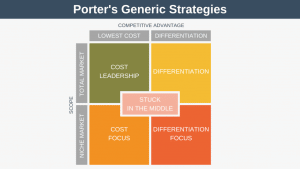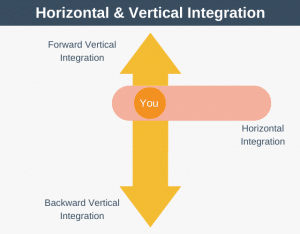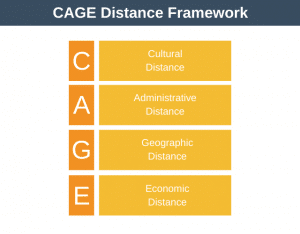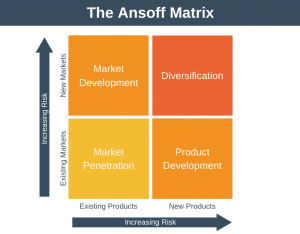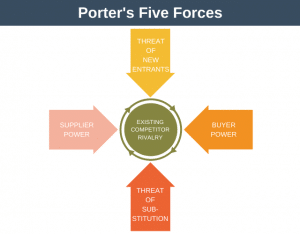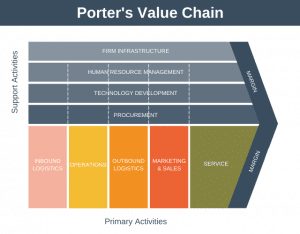VRIO framework is a strategic analysis framework that can help you uncover resources and capabilities within your organization that can give you a sustainable competitive advantage.
Many business leaders and organizations believe that the purpose of strategy development is to help them to compete to be the best. It isn’t. It’s about finding ways to be unique, different from all competition.
If you want to perform a strategic planning process, you’ll need to begin by analyzing your environment. To do this, you examine the:
- Macro-environment: This is the big picture. What’s happening in the world, including political, social, economic, and technology trends.
- Micro-environment: This is what’s happening in your market. It means analyzing your competitors, suppliers, customers, etc.
- Internal environment: This consists of your employees, assets, and technology systems, amongst others.
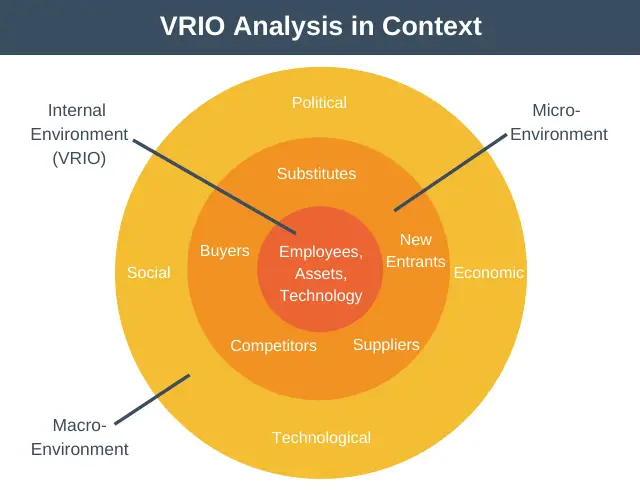
VRIO analysis is one of many strategy tools you can use to help you understand your internal environment. It enables you to analyze your internal resources and capabilities to uncover sources of sustained competitive advantage.
The VRIO Framework
VRIO is an acronym standing for Valuable, Rare, Inimitable, and Organized. The framework provides a way to analyze your resources and capabilities to uncover a sustainable competitive advantage.
What the VRIO framework says is that in order to have a sustainable competitive advantage, one of your resources must be valuable, rare, inimitable, and organized.
Examining resources and capabilities in this way is often referred to as a resource-based view (RBV). Resource-based view works on the premise that resources and capabilities are fundamental to superior performance for a firm.
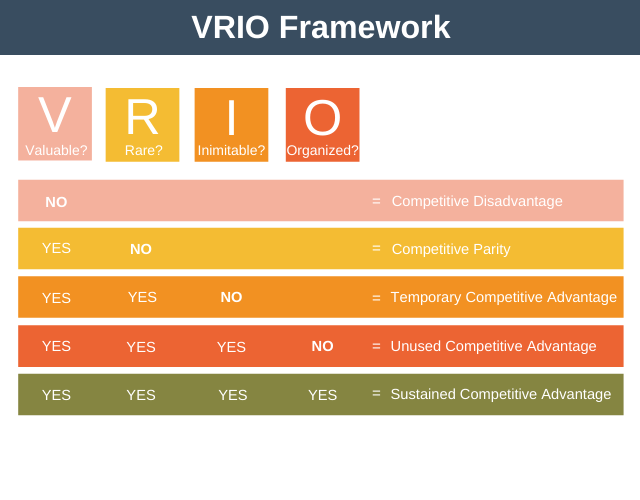
Let’s take a more in-depth look at each element of a VRIO analysis. For each resource or capability, you possess, ask the questions below in turn.
Note that when you use the VRIO framework you must progress through each question in the order shown, meaning valuable first and organized last.
1. Valuable
Is the resource or capability valuable to your firm? Does the resource allow your organization to take advantage of opportunities or defend against threats?
- YES: The resource is valuable, and the resource is a strength of your organization.
- NO: The resource in question isn’t valuable, and you need to examine other resources and capabilities to find value.
If you cannot find any valuable resources, then you are at a competitive disadvantage.
An example of a valuable resource might be your R&D team. They allow you to constantly innovate so you don’t fall behind your competition.
2. Rare
Is the resource owned by you and difficult for your competitors to acquire? Is it likely to remain challenging for your competitors to acquire in the future?
- YES: The resource or capability is rare and valuable and is a strength of your organization.
- NO: The resource or capability in question is valuable but very common. It is easy to acquire. This makes competing in the marketplace more difficult. Keep examining your resources to try to find one that meets this criterion.
If you can only find assets that are valuable but not rare, then your organization is at a position of competitive parity. You will find it difficult to sustain being ahead of your competition.
As an example of a rare resource consider Google. They have the most used search engine in the world. This scale is rare and difficult for competitors to beat.
3. Inimitable
Is the resource or capability difficult or expensive for other firms to imitate?
- YES: The resource or capability is rare, valuable, and difficult to imitate, making it a strength of your organization.
- NO: Although the resource is valuable and rare, it would be quite easy for other firms to copy. Keep examining your resources to try to find one that meets the three criteria.
If you can only find resources that are valuable and rare but easy to imitate, then according to VRIO, your business is at a temporary competitive advantage.
As an example of an inimitable resource consider Coca-Cola. The Coca-Cola recipe is secret thus and impossible to imitate. Even if a competitor created a cola that tasted exactly the same it still couldn’t say it was using the Coca-Cola recipe.
4. Organized
Does your organization exploit the resource or capability? Is your organization set-up (organization structure, measuring the right values, awarding bonuses, and target setting) to exploit the resource?
- YES: Your company has found a resource or capability that gives it a sustained competitive advantage. It’s still important to keep looking for other resources that meet all four criteria.
- NO: Although you possess a resource that is valuable, rare, and inimitable, your organization isn’t organized to realize its potential. If you find yourself in this situation, you have what’s referred to as an unused competitive advantage.
Even if you find just a single resource or capability providing a sustained competitive advantage, your organization is in a great position to remain ahead of the competition well into the future.
Looking again at Coca-Cola as an example, their secret recipe provides sustained competitive advantage as the company is organized to take advantage of it. The recipe is a closely guarded secret and the company advertises around the fact that they have their own unique and secret recipe.
Overall, the process you go through for each resource or capability you identify is as follows:
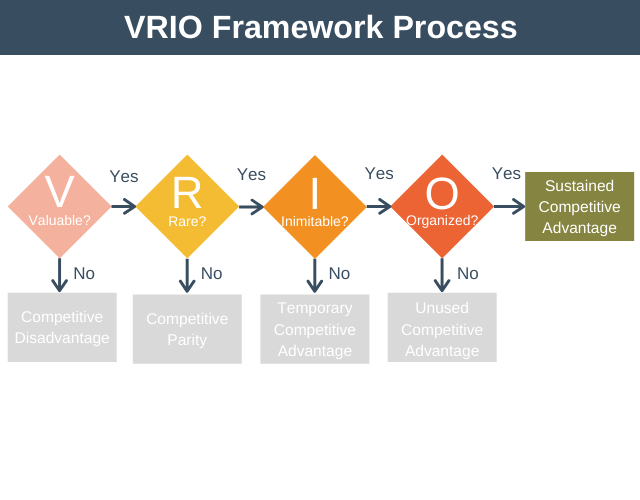
Background
The VRIO framework was created by Jay B. Barney, a professor of Strategic Management at the University of Utah.
Barney developed the model for his book, written with William S. Hesterly in the 1990s, Strategic Management and Competitive Advantage.
The VRIO framework is actually based upon another model called the VRIN framework. VRIN stands for Value, Rareness, Imitability, and Non-substitutable.
Changing the last letter of the model from “N” to “O” highlights the fact that an organization needs to capitalize on any resources that are a source of competitive advantage to reap sustained benefits from that competitive advantage.
VRIO Framework Example: Nike
For a simple example of how to use the VRIO framework lets examine Nike.
| Resource or Capability | Valuable? | Rare? | Inimitable? | Organized/ | Impact of Resource |
|---|---|---|---|---|---|
| Human Resources Management | Yes | No | No | No | Competitive Parity |
| Technical Knowhow | Yes | No | No | No | Competitive Parity |
| Cost Efficiency | Yes | No | No | No | Competitive Parity |
| Relationships with governing bodies | Yes | Yes | No | No | Temporary Competitive Advantage |
| Relationships with athletes | Yes | Yes | No | Yes | Temporary Competitive Advantage |
| Innovative products/patents | Yes | Yes | Yes | Yes | Sustained Competitive Advantage |
| Nike brand | Yes | Yes | Yes | Yes | Sustained Competitive Advantage |
As you can see, Nike has two resources or capabilities that provide it with long term competitive advantage, innovative products, and associated patents, as well as the Nike brand.
These two resources are valuable as Nike can use them to drive revenue directly. They are also rare; for example, you can’t merely copy Nike’s patents. They are costly to imitate, for example, it would cost billions for dollars in advertising over many years for a new competing brand to build up the same brand recognition as Nike has. The organization is also structured around these capabilities so as it can continue to be a source of competitive advantage long into the future.
In the VRIO example for Nike, you can also see that Nike’s relationship with athletes doesn’t provide a sustained competitive advantage. Why not? One reason is that a competitor could outflank Nike in this regard by more aggressively signing up young and promising athletes.
Understand that Nike’s relationship with athletes is still a definite advantage of the firm, but it isn’t the source of long-term sustained competitive advantage.
Finally, note that the row for “Relationship with athletes” has the answer: yes, yes, no, yes. The important thing to note is that as you read the row from left to right, as soon as you reach the first “no” this is where you stop your analysis.
Advantages and Disadvantages
The benefits of the VRIO framework include:
- It’s an easy model to apply.
- The model can help a firm to identify unused competitive advantages that you can then transform into a sustained competitive advantage.
The disadvantages of the VRIO framework include:
- It’s very difficult to apply to smaller firms and startups as they might not yet have enough resources or capabilities to be able to identify any sustained competitive advantage.
- The world in which firms operate is changing all of the time. This means that it could be difficult to say you’ve ever achieved a sustainable competitive advantage, the best you can do is say that you have a competitive advantage for the foreseeable future.
- The model doesn’t consider internal factors, for example, how demand in the marketplace is shifting and changing.
Summary
VRIO analysis is an acronym standing for Valuable, Rare, Inimitable, and Organized. VRIO analysis is a tool that can help you to analyze your resources and capabilities to identify or develop points of sustained competitive advantage.

